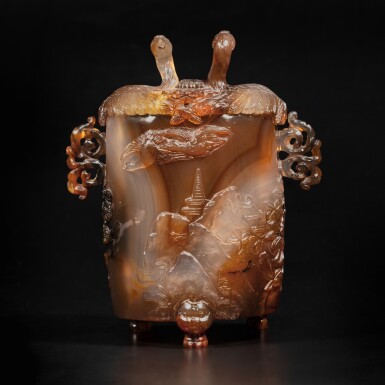Chinese Art
Chinese Art

Property from a Distinguished North American Collection
A rare and exceptionally carved agate 'geese' tripod censer and cover, Qing dynasty, Yongzheng / Qianlong period
Auction Closed
September 18, 08:03 PM GMT
Estimate
200,000 - 300,000 USD
Lot Details
Description
(2)
Height 3⅝ in., 9.3 cm
Collection of William H. (1848-1923) and Ada Small (1858-1955) Moore.
Collection of William H. Moore II (1914-2009).
Gifted to Yale University Art Gallery, New Haven, in 1955 (accession no. 1955.1.6).
Deaccessioned and reacquired by William H. Moore II (1914-2009), 9th March 1967.
Capturing a glorious spectrum of cloudy white, rich persimmon-orange and dramatic inclusions of chocolate brown, the captivating color of the agate material alone is grounds enough to see the present piece for what it is: an exceptional imperial treasure. Unlike the relative calm of the preceding Ming dynasty, the early Qing saw decades of ongoing battles to secure control of the northwest which disrupted trade routes and limited access to much beloved jade. Although alternative sources of jade from Russia and beyond were imported to the court, these rarely met the emperor's exacting standards. Thus, only truly resolved with the annexation of the western provinces in the twenty-fourth year of Qianlong's reign (1759), this disruption forced the artisans of the Imperial Jade Workshop, yuzuo, in Beijing to embrace other materials including turquoise, coral, rock crystal and, in this case, agate.
Although the fine carving on the surface, cover and handles of the censer may be indicative of the masterful detail-work of the Qianlong period, the subdued subtle color and serene scene captured in the present lot are typical of Yongzheng's taste. Compare a number of agate bowls, cups and a water dropper of minimalist design bearing the mark of the Yongzheng Emperor in the collection of the Palace Museum, Taipei, included in the exhibition Harmony and Integrity. The Yongzheng Emperor and His Times, Taipei, 2009, cat. nos II-61 to II-70; as well as a cup of Yongzheng mark and period sold in our Hong Kong rooms, 8th October 2014, lot 3774.
The Yongzheng Emperor, and to a lesser extent his son Qianlong, had a great appreciation for the serene. Only ascending the throne at the age of forty five, Yongzheng (then known as Prince Yinzhen) had spent his youth and adult life in relative calm, with China at peace, wandering through the glorious palaces and gardens that would soon be his inheritance. In what began as a gift from his father, Kangxi, Yongzheng dedicated himself to the expansion of the Old Summer Palace, the Yuanmingyuan, northwest of Beijing and constructed elaborate water features, pagodas and scenic spots across the garden. Expanded on by Qianlong, these scenic views of rocky crags and pagodas with cranes overhead may well be the inspiration for the present lot, which speaks to a life of tranquil luxury far from the chaos of the capital.
Delicately carved across the cover and soaring above the landscape below, the combination of cranes and pine trees is also steeped in symbolism. Captured in the adage 'song he yan nian' or 'pines and crane extend your years,' this decorative motif has long been associated with longevity and a long life of tranquility. Depictions of the evergreen needles of pine that endure even the toughest snow storm and the cranes on which immortals were said to ascend to heaven are found commonly on the imperial wares of the High Qing; compare the famous 'Yangcai Crane and Deer Ruyi Vase' sold in our Paris rooms, 12th June 2018, lot 1.
The delicate yet imposing form of this agate censer is incredibly rare and no directly comparable pieces of this type appear to have ever arrived on the market. In its cylindrical shape, resting on three archaistic animal heads, the piece is reminiscent of an earlier jade vessel type, variously dated between the Song and the Ming dynasties, of archaistic design and cylindrical form resting on three legs with a single handle in the form of an archer's ring; compare examples illustrated in Roger Keverne, Jade, London, 1991, p. 138, fig. 25 and p. 143, fig. 35; and another together with an intact cover with protrusions in the shape of three rams' heads from the Qing court collection, illustrated in The Complete Collection of Treasures of the Palace Museum: Jadeware (II), Hong Kong, 1995, pl. 185. Though the delicate scrollwork handles, finely carved naturalistic design and delicate radiance of the present lot differ quite substantially from the archaism of the earlier type, the two are nonetheless closely related in their grandeur. Compare also hardstone carvings of cranes in other contexts including an agate water dropper in the shape of a crane from the collection of Heber R. Bishop, now in the Metropolitan Museum of Art (accession no. 02.18.87a,b) and a white jade sculptural group of cranes beside a pine tree from the Junkunc Collection, sold in these rooms, 22nd September 2020, lot 244.
A well renowned lawyer and financier, William Henry Moore (1848-1923) (Fig. 1) came to prominence as one of the creators of the mass conglomerate United States Steel, as well as a number of other high profile companies, from the First National Bank to the National Biscuit Company ('Nabisco'). Together with his wife Ada Small Moore (1858-1955), Judge – as he was known – amassed a sizable and important collection of world art, with a particular interest in pieces from the Islamic world, ancient Greece and China. This collection was bequeathed to the Yale University Art Gallery on Ada's death in 1955 and marked with accession numbers in thick red handwriting, commensurate with those on the cover and base of the present lot.
